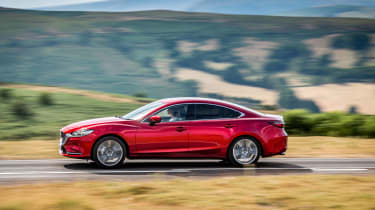Mazda 6 (2012-2022) - MPG, CO2 and running costs
Strong fuel economy and low emissions combine with Mazda reliability and value for money to ensure low running costs

Just so you know, this is an older review of the 2012-2022 Mazda 6. If you are interested in information about a used Mazda 6, or news about the latest Mazda models, please follow the links provided.
Mazda developed its SkyActiv engine range to achieve strong fuel efficiency and low emissions. Customers looking for the best return from a tank of fuel might wish to look out for a SkyActiv-D 150 diesel model which, although now discontinued, provides a much healthier mpg figure than its petrol siblings.
This engine claims 55.4mpg fuel economy and CO2 emissions of 117g/km, despite its well rounded performance. These figures are poorer than before and mean company car costs will be higher, but you won't see worse economy in everyday driving. It comes as standard with engine stop/start, which Mazda refers to as i-stop, and an energy regeneration system called i-ELOOP.
The SkyActiv-D 184 engine isn’t quite so efficient, but still averages 53.3mpg. CO2 emissions of 124g/km are competitive for an engine with such strong performance. Go for an auto gearbox and efficiency drops slightly, with both diesels emitting 133g/km of CO2 and claiming 47.9mpg.
Petrol versions of the Mazda 6 are efficient for their type, although nowhere near as good as the diesels. The 143bhp engine has an official economy figure of 42.2mpg for the manual and 40.4mpg for the auto, with CO2 emissions of 152g/km and 159g/km respectively. The 163bhp unit comes solely with the six-speed manual gearbox and promises 42.2mpg with 152g/km of CO2.
The larger 2.5 Skyactiv-G petrol returns 38.2mpg combined in the WLTP test, and emits 167g/km of CO2.
Insurance groups
As all cars get Mazda's Smart City Brake autonomous emergency braking system as standard, insurance groups are competitive. They start at Group 20 for SE-L models, then move up to Group 22 for Sport Nav models, and Group 26 for the GT Sport Nav with its 2.5-litre petrol motor. Car insurers value this safety assist technology so highly, they’re willing to lower insurance ratings accordingly.
Depreciation
Mazda has enjoyed strong residual values in recent times on the back of its move upmarket and the Mazda6 is no exception, retaining around 40% of its value over a typical three-year/36,000 mile ownership period. This compares well with the Ford Mondeo and Vauxhall Insignia, but also with premium rivals like the Audi A4 and BMW 3 Series.









